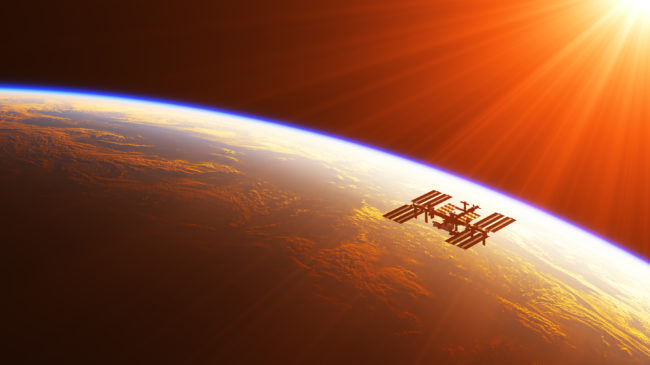The International Space Station (ISS) is deteriorating and it is no secret that this almost 20-year-old structure is coming to the end of its lifespan. With recent air leaks and other structural issues, the station’s international astronauts will soon need to vacate the ISS and find new opportunities to collaborate elsewhere in orbit.
Such realities should cue developments in the commercialization of the International Space Station and encourage building commercial space stations.
The ISS has historically been a facility for shared civil and peaceful scientific exploration of space and was intended to be a public facility to promote diplomatic relations through in-orbit experiments. In the past, outside American experiments sent up to the ISS had to show educational purposes and NASA astronauts were prohibited from working on commercial projects at the ISS that could possibly turn a profit. However, in recent years NASA has opened up work on the ISS to commercial businesses.
Commercial endeavors on the ISS currently include projects from companies such as Made in Space sending up 3D printers to help astronauts create tools on the ISS and Nanoracks creating a commercial airlock to deploy satellites from the ISS. Near-term projects include developing a better understanding of microgravity research by companies and private astronauts’ use of the ISS.
But commercial endeavors are not stopping with technical projects. On Northrop Grumman’s recent Cygnus trip to the ISS, the craft carried a payload containing 10 bottles of face creams from cosmetics giant Estée Lauder. NASA entered a contract with the company to facilitate pictures of Estée Lauder’s products with space backdrops of Earth and the space station for the company’s social media marketing campaigns. Unconventional uses of the ISS may also eventually expand to include space tourism.
Why is it important for NASA to be open to commercial activities? Simply put, the ISS is expensive to run and NASA wants and needs out. The ISS, despite being shared with the Canadians, Japanese, Europeans, and Russians, costs the United States $3 to $4 billion a year to operate. For this reason, NASA has expressed a desire to eventually hand over the NASA portion of the ISS to American commercial companies moving forward and to use the federal money allocated to the ISS to pursue new goals in space.
In 2018, President Donald Trump’s budget plan suggested stopping funding the ISS by 2025, but pushback nixed this policy. However, ideas about the future of the ISS need to be revisited. As of now, NASA seems likely to use the ISS as a commercial venture and use the commercial revenue to fund it, thereby freeing up the current ISS budget to go towards newer NASA goals such as the Artemis program and a lunar orbiting station.
Beauty companies and other marketing campaigns on the ISS, although foreign and historically inappropriate to some, could be extremely useful revenue streams in the future that would enable more innovative NASA goals to launch.
NASA’s commercialization of the ISS also aligns with the agency’s plan to encourage a sustainable commercial environment in lower-earth orbit (LEO) from which NASA can purchase services. More opportunities for LEO development would increase interest for commercial companies to branch out on their own.
Recently, Jeff Bezos’s Blue Origin posted a job opportunity for an “Orbital Habitat Orbitation Lead” in charge of leading the company’s development of commercial space stations in LEO. This role would view NASA as a prime customer and work towards Bezos’ goal of creating a robust environment for humans to live in space.
NASA will need services in LEO as the U.S. looks towards Mars and Venus exploration. It would be much more economically sustainable for NASA to purchase these services already on commercial space stations than try to supply itself with everything.
Some may argue that the ISS is vital to international cooperation and peace in space, and that decommissioning it will be dangerous. For the last 20 years, the ISS has been useful to maintain international relations among many countries, particularly the U.S. and Russia. International partnerships in scientific space exploration are equally important today.
For this reason, NASA is currently working towards a new international space station. NASA currently holds a contract with Axiom Space to build an “Axiom Segment” on the International Space Station that will eventually branch off from the old ISS to create a new outlet for international cooperation as a commercially-run station. This should help maintain old relationships with power players in space as well as open opportunities for new spacefaring nations to enter the mix. With more countries building their space programs, and with Russian and Chinese power increasing in space, having a diplomatic station that NASA plays a major role in will remain important moving forward.
Right now, the ISS is sucking up far too much of NASA’s limited funds. NASA should be focusing beyond LEO toward exploration further into the solar system and funding the outdated ISS is making that difficult. The more companies want to build in LEO, the more NASA should be encouraging these projects. Services in lower-earth orbit by private industry will enable NASA and other nations to move further into space. Terminating the ISS would not be a funeral, but a chance to propel America and the world into a much broader space environment.
Commercialization in space is on the horizon and cannot be squashed. The days of NASA developing products without commercial partnerships are over. With NASA’s help, more startups and innovators will be able to make their debut in LEO and help America remain the leader in space. Policymakers need to stop pushing back on proposals to support these goals.

